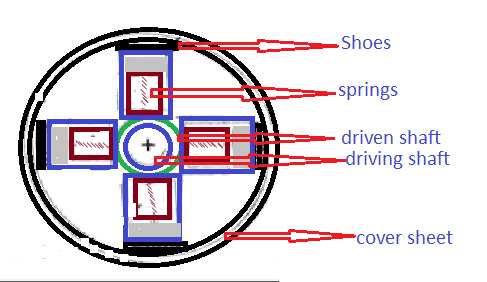Effect of Gyroscopic Couple on a disc fixed at a certain angle on a rotary shaft
Let us discus about the effect of gyroscopic couple when the shaft contained with disc is rotating, by consider a fixed disc on a rotating shaft of mass “m”, the angle made by the polar axis with respect to the disc is ”θ” with respect to the shaft axis.
From front view we can absorve that the shaft rotates with angular velocity “ω” rad/s
The angular velocity of spin of disc about polar axis “op”= ω cos θ.


Effect of gyroscopic couple on rotating disc placed at certain angle:
When a rotating disc is placed at a certain angle and subjected to rotation, the gyroscopic effect induces a phenomenon known as gyroscopic couple. This effect is a result of the conservation of angular momentum and can have specific consequences on the behavior of the rotating disc. Let’s explore the effects:
- Precession:
- The most significant effect of gyroscopic couple is precession. When a force is applied to tilt the spinning disc, the gyroscopic couple acts perpendicular to both the applied force and the axis of rotation. As a result, the disc’s axis starts to precess, meaning it rotates around a vertical axis.
- Change in Direction:
- Gyroscopic couple causes the rotating disc to resist changes in the direction of its axis. If an external torque is applied to tilt the disc, the gyroscopic effect will act perpendicular to the applied torque, causing the axis to shift in a direction that minimizes the torque.
- Stabilizing Effect:
- The gyroscopic effect has a stabilizing influence. If the rotating disc is initially spinning and stable, any disturbance causing a change in orientation will be resisted by the gyroscopic couple. This property is utilized in various applications, such as gyroscopes in navigation systems.
- Angular Momentum Conservation:
- Gyroscopic couple arises due to the conservation of angular momentum. As the spinning disc is tilted, the gyroscopic effect generates a force to maintain the original direction of angular momentum. This conservation principle is fundamental to the gyroscopic behavior.
- Applicability in Gyroscopes:
- Gyroscopes, which often consist of a spinning disc or wheel, utilize the gyroscopic couple to maintain a stable orientation in space. This property is exploited in navigation systems, aircraft control surfaces, and other devices requiring precise control of angular motion.
- Effect on Stability in Vehicles:
- In vehicles like bicycles and motorcycles, the gyroscopic effect can contribute to stability. The rotating wheels act as gyroscopes, and their gyroscopic couple resists changes in orientation, helping the vehicle maintain balance.
- Torque Generation:
- The gyroscopic couple also results in the generation of a torque perpendicular to the applied force. This torque is proportional to the product of the angular velocity, the applied force, and the separation distance between the point of force application and the axis of rotation.
It’s important to note that the effects of gyroscopic couple are more pronounced at higher rotation speeds and become significant when the angular velocity is substantial. Additionally, the direction of the gyroscopic couple is perpendicular to both the applied force and the axis of rotation, following the right-hand rule. The specific consequences of gyroscopic couple depend on the orientation, magnitude of angular velocity, and external torques applied to the rotating disc.
Frequently Asked Questions – FAQs
- What is gyroscopic couple, and how does it affect a rotating disc at a certain angle?
- Answer: Gyroscopic couple is a phenomenon resulting from the conservation of angular momentum. When a rotating disc is tilted, the gyroscopic couple acts perpendicular to the applied force and the axis of rotation, causing precession.
- How does gyroscopic couple contribute to precession in a rotating disc?
- Answer: Gyroscopic couple induces precession, causing the axis of the rotating disc to rotate around a vertical axis when subjected to an external force.
- What role does angular momentum conservation play in gyroscopic effects on a rotating disc?
- Answer: Gyroscopic couple arises due to the conservation of angular momentum. The spinning disc resists changes in its orientation to maintain the original direction of angular momentum.
- In what applications is the gyroscopic effect on rotating discs commonly utilized?
- Answer: Gyroscopic effects are utilized in gyroscopes for navigation systems, aircraft control, and stabilization in various engineering applications.
- How does the gyroscopic effect contribute to stability in vehicles like bicycles and motorcycles?
- Answer: The gyroscopic couple in rotating wheels contributes to stability by resisting changes in orientation, helping vehicles maintain balance.
- Can the gyroscopic effect be manipulated to control the orientation of a rotating disc intentionally?
- Answer: Yes, the gyroscopic effect can be intentionally used to control the orientation of a rotating disc. This is a fundamental principle in the design of gyroscopic devices.
- What happens if an external torque is applied to a rotating disc at a certain angle?
- Answer: The gyroscopic couple resists the external torque, causing the rotating disc’s axis to shift in a way that minimizes the applied torque. This behavior is part of the stabilizing effect.
- Does the gyroscopic effect vary with the speed of rotation of the disc?
- Answer: Yes, the gyroscopic effect becomes more pronounced at higher rotation speeds. The magnitude of the gyroscopic couple is proportional to the angular velocity of the rotating disc.
- Can the gyroscopic effect contribute to torque generation in a rotating disc?
- Answer: Yes, the gyroscopic effect generates a torque perpendicular to the applied force and the axis of rotation. This torque is proportional to the angular velocity, applied force, and separation distance.
- How does the direction of the gyroscopic couple relate to the applied force and the axis of rotation?
- Answer: The direction of the gyroscopic couple follows the right-hand rule, being perpendicular to both the applied force and the axis of rotation. This direction is essential in understanding the resulting precession.


